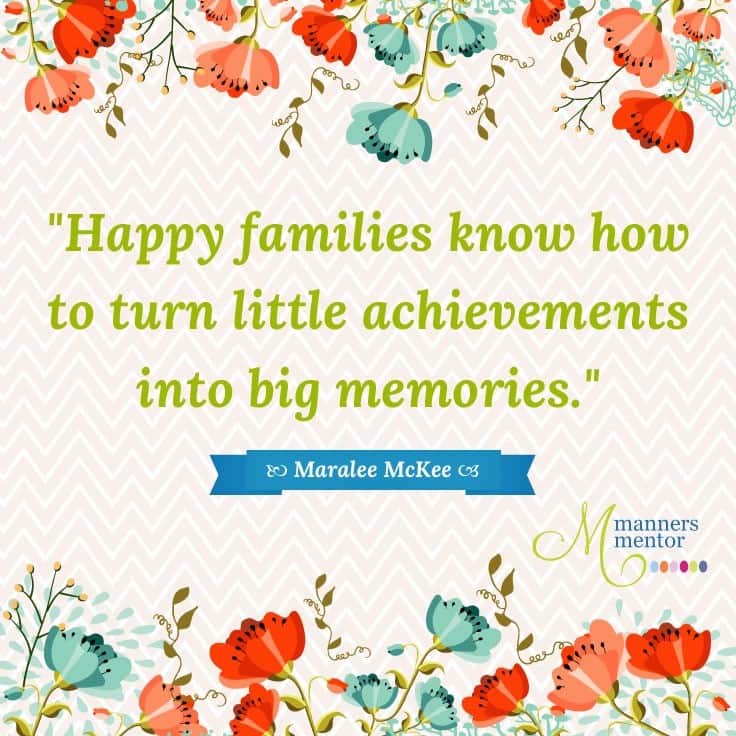We all long to have a happy, loving family and a peaceful home life. Happy families come in all shapes and sizes. Yet they share a set of common courtesies that they weave into their daily interactions with one another. The list is long, but here you’ll find seven of the top courtesies that happy families have in common.
By: Maralee McKee, Manners Mentor
Leo Tolstoy began Anna Karenina with his famous line, “All happy families resemble one another….”
He struck truth.
Families who define themselves as “happy” share a certain characteristic: they have standards for interacting with one another (manners) and agreed upon ways of doing so (etiquette), and they make these courtesies a habit.
Are the courtesies stuffy or old-fashioned? Nope!
Do the courtesies suppress personality? Yikes, No!
Are the habits the same for the adults and children in the home? Yep! (That’s because “Do as I say, not as I do.” is hypocritical, and it doesn’t work.)
How do these courtesies make a difference? They raise the happiness quotient in our homes by setting wise boundaries, by making everyone’s expectations of one another clear, and by giving us concrete ways to live out the golden rule in the most personally impacting place in the world, our home.
Happy, Loving Families — How to Get Their Courtesies To Work for Your Home
At the core of the seven courtesies in the list below are respect, selflessness, and love in action.
It’s rare for them to come naturally. If we’re honest, we all have a “me first” attitude that’s eager to trip us up.
We have to be committed to them, willing to push through the hard days when we feel like shutting ourselves away, and instead draw those we love closer to us.
In short, we have to be intentional about these actions until they dwell deeply in us. They need to become a fluent part of our natural love language. And we need to speak them without a trace of our old accent (ways) sneaking through.
What if you’re gung-ho for them, but your spouse doesn’t sense the value in them right now?
We lead best through example. Once these courtesies characterize who we are, they’ll eventually overflow to our spouse. In time. (Your mileage may vary.) Your spouse will first come to admire them in you, and then as even more time goes by, he or she will take them to heart.
As for our children, we teach them in the same way, but we also bring up in conversation the “why” behind them. Children love knowing the “why” of things, and once they do, they’ll often surprise us with what they’re more than happy to rise to the occasion for. (I share more about that in this post, 3 Ways to Teach Manners So Your Child Will Use Them.)
(I share the formula for teaching social and people skills to our children without becoming the etiquette police in my award-winning book Manners That Matter to Moms, now sold exclusively here.)
How to Have a Happy, Loving Family — The Top 7 Courtesies of Happy Families
The following are in no particular order. Some are more consequential than others, but all of these courtesies have a permanent seat at the table of happy, loving families.
1. They say hello and goodbye: The comings and goings of the day are acknowledged. Whether Mom is coming home from work, big sister is going out to the movies, or little brother is off to his martial arts class, by saying hello and goodbye, they’re recognizing the events of daily life and reminding each other that their family cares about the details of their life. Big sister might say to little brother as he and Dad head out the door to karate practice, “Goodbye, Dad and Mason! Good luck with your new nunchuck routine, Mason!” Greeting others, whether they’re family or clients, is an art, but an art that’s easy to master. Manners for Great Greetings has got you covered.
2. Closed doors are respected because they teach and remind us of other important boundaries, too: The time and privacy of family members are held in high regard. Everyone is taught to: knock on the door, announce yourself, say why you’re knocking, and then wait for a response before opening the door. For example, Jocelyn, one of three teen girls in the house, her laptop in hand, might knock on Mom’s bedroom door and say, “Mom, it’s Jocelyn. May I have your help with figuring out how to upload a video into my science report?”
3. Meals are eaten together…a lot: At the dining table (breakfast, lunch or dinner), the small victories (your oldest child won the class spelling bee) and the inevitable heartaches (your youngest child’s goldfish died) are given the attention they deserve.
As much as our bodies need the healthy food served at the table to stay strong, our hearts need the conversation, connection and attention paid to one another to stay truly happy.
A well-regarded study by Dr. Blake Bowden of Cincinnati Children’s Hospital found that poorly adjusted teens shared a table, meal and quality conversation with their family three or fewer times per week.
Mildly adjusted teens did the same five times a week.
Well-adjusted teens (those most likely to stay away from drugs, complete school, and have healthy, happy relationships now and later) ate together with their family seven or more times per week at home or in a restaurant. (The meals were distraction-free zones with no electronics at the table and the TV turned off.)
Mealtime is the best time to share and pass along your values, manners, and hopes to your family. That’s one reason why it’s often said that the kitchen is the heart of the home.
4. Put-downs are quickly shut down: There’s no kidding about someone’s looks, talents, or lack thereof in happy families. All put-downs, even the “Hey, he knows I’m only messing with him!” ones aren’t allowed.
Words linger long.
Any that don’t uplift or encourage the other person don’t get a pass because they’re said under the guise of a joke.
It’s considered bullying.
And it’s not tolerated in happy families.
When it does happen, real apologies follow, meaning the person(s) apologizing understand what they did was hurtful and why. Sincere apologies have other essential elements. You can find out more in How to Apologize: The 7 Steps of a Sincere Apology.
In contrast, compliments and words of love and appreciation flow freely and without embarrassment in families where joy is a cornerstone.
5. They build a strong family identity: My husband, boys, and I have a family cheer. When things are going great, we say it, and when we need reminding that this too shall pass, we say it.
“McKee’s! McKee’s! McKee’s! Together Forever! McKee’s!”
Corny? I prefer “Awesome!”
Does it build us up individually and bring us closer together as a family? Definitely!
Happy families know-that-they-know that other family members have their backs, and that there are multiple hands reaching out to give them a hand-up when needed.
The Siamese twin of building your family identity is building family standards.
My boys have been taught (and are still being reminded) that being a McKee is a great thing to be, a privilege even! It’s the same for your family!!!
And like all privileges, with the benefits come responsibilities. There are boundaries we don’t cross because it’s not the “McKee way,” and there are standards we rise to that might take extra time or effort, but we do it because it’s a “McKee thing” to do.
6. The best of things and the best of themselves aren’t saved for company: Our good china and good manners shouldn’t be saved for guests.
Happy families know how to turn little achievements into big memories.
It’s not because they love party planning. It’s because they value celebrating one another.
Get out the good china, light some candles, and celebrate with frozen pizza, PB&J, or take-out Chinese that Dad finished his CE credits for the year, Mom ran her first mile in under nine minutes, or Carlos aced his first pre-algebra test.
And while Mom might insist that adults and children alike say, “Yes, please!” and “No, but thank you for offering.” when the neighbors come over, happy families use the same pleasant tone and words of respect 24/7, 365.
They understand that if you don’t give your best to your family, then when you give it to others, it’s only window dressing.
7. They understand that your full attention is a full measure of your love: They seem to hand out medals these days for multitasking. A long, checked to-do list is the prize of the American work ethic whether at home or in an office.
We’ve been mislead.
Sure, each day has important things that need our attention. There are tasks we have to complete, or our family or business infrastructure will collapse.
However, when we split a task into multiple parts to be able to do part while we’re listening to our spouse or children tell us something, we’re only giving them a fraction of ourselves.
When we just can’t talk at the moment, it’s kinder to tell them than to only partially listen. We can do this by:
~explaining what we’re doing, asking if they mind if we continue while they talk, and assuring them they have the majority of our attention.
or
~telling them we want to give them our full attention, explaining quickly what we’re doing, and giving an estimate of when we’ll be finished. Ask whether we can talk then.
Happy, Loving Families Do Resemble One Another
While every happy, loving family is unique, all of them share common attributes. The list above is only seven of them. There are more, of course, but these are daily ones that might seem small (knocking on closed doors and waiting for an answer before entering) or perhaps aren’t obvious (building a family identity), but they are strong foundation builders. Making these a part of who your family is today will cause your children to one day carry them to their own family.
Actions, positive or negative, ripple down through generations. The bad ones are a tsunami that tear apart families. The good ones are like a gentle rain penetrating the soil and getting to the roots of the plant, helping it to grow without harming the beautiful flower of a happy family.
What Do You Think?
Join me on the Manners Mentor Facebook page to share what you’d add to the list above. What are the top courtesies in your home that help make it a terrarium that sprouts happiness for your family?
If you enjoyed this post, please subscribe here and you’ll receive a FREE PDF copy of my illustrated guide on handling any meal with confidence and savvy. It’s a fun and easy read that pays a lifetime of dividends!
Also, please like, share, Pin, Tweet, email and share this with your friends, family and those in your social media circle. Let them know that there are a lot of us who know that manners make a difference!
Until next time, remember to give the world the gift that you were created to give, you…at your best!
XOXO,




